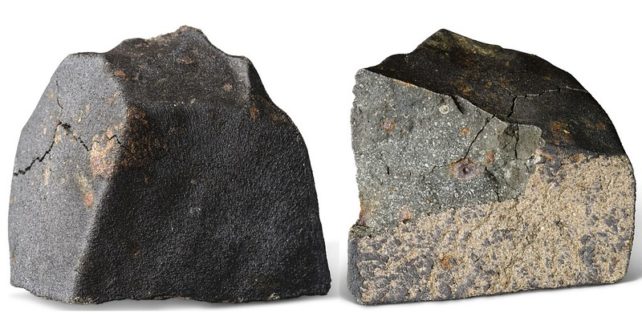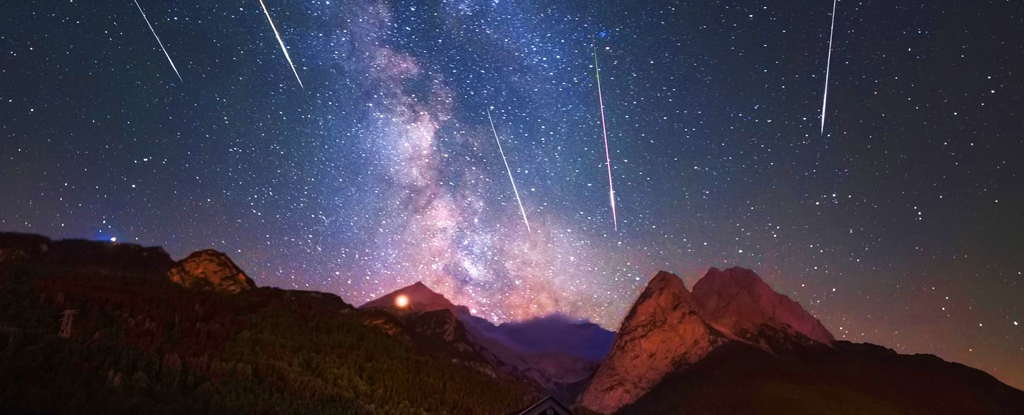Products You May Like
Earth is the only planet in the Universe known to host life, but even it was desolate at first. About 4 billion years ago, something happened to give our sterile rock the building blocks of life.
Amino acids, for example, needed to exist before Earth could have proteins, a vital component of all life forms. The origins of Earth’s amino acids remain murky, but some scientists suspect these organic compounds were delivered from space by meteorites.
In a new study, researchers reveal details about how that could have happened, supporting the idea that meteorites helped establish life on Earth.
The study shows how a certain class of meteorites called chondrites could produce their own amino acids thanks to reactions powered by gamma rays from the meteorites themselves.
Meteorites are chunks of ancient debris left over from the Solar System’s infancy that crash onto a planet or moon. Different types of meteorites feature different materials.
Chondrites are stony meteorites embedded with mysterious spheres known as chondrules. Made primarily of silicate minerals, chondrules are among the oldest objects in the Solar System.
Meteorites have bombarded Earth since the beginning, and some of the early barrages may have included carbonaceous chondrites – a relatively rare subcategory of chondrite that holds significant amounts of water and small molecules, including amino acids.
Such meteorites could have given Earth vital ingredients for life, but how did those ingredients get onto a meteorite in the first place?
We still aren’t sure, but the new study illuminates how chondrites (or their parent bodies) are at least theoretically capable of synthesizing these compounds.
Led by cosmochemist Yoko Kebukawa from Yokohama National University in Japan, the researchers sought to resolve questions from previous lab experiments investigating the potential formation of amino acids on carbonaceous chondrites.
Those experiments showed that simple molecules like ammonia and formaldehyde could generate amino acids, but only in the presence of heat and liquid water. In the new study, researchers examine a possible heat source from the meteorite: gamma rays.
Early carbonaceous chondrites are known to have contained aluminum-26, a radioactive element that can release gamma radiation as it decays. Kebukawa and her colleagues decided to test whether this could provide the heat needed to form amino acids.
Researchers dissolved ammonia and formaldehyde in water, sealed the resulting solution inside glass tubes, and then exposed the tubes to high-energy gamma rays from decaying cobalt-60.
As the dose of gamma radiation increased, so did the production of α-amino acids like alanine, glycine, α-aminobutyric acid, and glutamic acid, along with β-amino acids like β-alanine and β-aminoisobutyric acid.
The researchers note that these amino acids could help explain the presence of these amino acids on carbonaceous chondrites that have fallen to Earth, such as Australia’s famous Murchison meteorite.
Loaded with “presolar” silicon carbide particles (meaning they’re older than the Sun), the Murchison meteorite exploded in the sky over Murchison, Victoria, on 28 September 1969. It was a widely observed event; people collected a trove of fragments from the area afterward. It has since become one of the most studied space rocks in history.
Among many interesting finds, the Murchison meteorite was packed with amino acids. Scientists have so far identified more than 70 amino acids from the meteorite, only 19 of which are known from Earth, according to Museums Victoria.
This has stirred widespread fascination, suggesting that life on Earth’s basic chemical building blocks can also easily form elsewhere.

In the new study, Kebukawa and her colleagues investigated how amino acids might arise on a meteorite like this and how long it might take.
Based on their results, plus the expected dose of gamma radiation from decaying aluminum-26 in meteorites, they estimate it would take between 1,000 and 100,000 years for this process to generate the amount of alanine and β-alanine found on the Murchison meteorite.
Although we still have a lot to learn about abiogenesis, or the spontaneous generation of life, the researchers say this study shows how reactions sparked by gamma rays can produce amino acids on a meteorite, potentially contributing to the origin of life on Earth.
The study was published in ACS Central Science.
